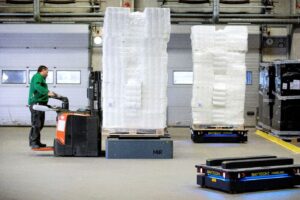In 2022, automation has accelerated across all industries and ecosystem types, towards new implementations and progress in the development of new technologies. In 2022 and for years to come, this category is expected to go faster and further than ever before.

Birol Esmer, Product Manager, Software at Mobile Industrial Robots shares an overview of automation today and in the future.
How has the landscape changed in terms of implementation of robotic systems in all industries?
The ever-increasing global demand for automation has increased the adoption of technologies such as artificial intelligence and machine learning for industrial developments. Among the technological advances, autonomous mobile robots (AMR) are increasingly becoming an integral part of many companies in the world.
As we now see more and more production facilities of all sizes around the world, the number of robots required to be deployed in applications or the size of fleets is increasing.
In the past we had fleets of an average of 3 or 4 robots, today we have larger and larger fleets worldwide and that is a big trend that we are seeing more robots on the work floors that bring with them new opportunities.
Robotics facilitates the rise of the human “knowledge worker,” but decision-makers must prepare staff for the inevitable changes in their current jobs, allowing them to upskill, specialize and retrain when necessary.
What are some of the key barriers to entry for companies wanting to deploy automation?
Industrial automation and robotic systems have now advanced to a stage where they are more capable, cheaper than before, and easier to integrate and install within software technology. Some of the main barriers are:
- Fear of change: Organizations have spent years perfecting their manufacturing processes, selection lines, and production processes to be as efficient as possible. These operations are essential to the success of a company and its ability to meet the expectations of its customers. As a result, companies can be reluctant to rethink their set up with automation.
- Lack of flexibility within the solution: Related to an initial fear of high capital costs is the fear that once companies have committed to a solution, there is little room to deviate from what was decided at the outset.
- Flexible financing concepts, such as pay-as-you-go models, can help alleviate any potential concerns. These models can be combined with seasonal demand, usage patterns, or just general production. A pay-as-you-go solution can help simplify cost control and reduce the risk of your investment.
Aside from these, barriers such as fear of job loss and safety are also concerns that challenge the implementation of robots into facilities. Nonetheless, some of these barriers are also based on a lack of knowledge regarding solutions offerings in the market. Therefore, first step to overcome these barriers is to research the different solutions and understand what suits your need the best. Feel free to in touch with our automation experts for a free, non-binding conversation about your needs here.
What does the future of automation look like in the world?
A far cry from its early days on factory production lines, automation has entered organizations and found a place in the operations of all departments, and it is going nowhere in the future.
Combined with robotics, machine learning and artificial intelligence (AI), automation handles today and will handle in years to come the mundane tasks that people prefer not to spend time on, work that is ergonomically unsafe, dangerous, or bored.
While automation has evolved at lightning speed in recent years, it doesn’t seem like it’s slowing down. As we automate more business processes, we are headed for an interesting long-term paradox: Despite a century of creating machines to do our jobs, the proportion of adults in the world with a job has risen steadily over the past several years.
The role of automation will continue to be in the future to take care of the tasks that machines can do better than we can and, at least for the near future, this does not include creativity, management, or friendly human interaction one on one.
For best results, we must continue to create automation strategies that help teams focus on their most important work. Choose automation tools that free up time, connect your overall tech stack, and boost productivity and morale.
Watch cases from all over the world, learn more about how to get started with AMRs and get in touch with our automation experts on our website: https://www.mobile-industrial-robots.com/




